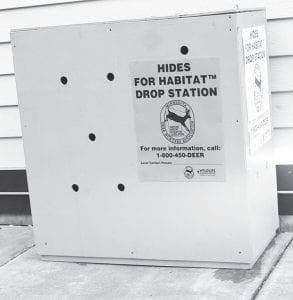The local Arrowhead Chapter of the Minnesota Deer Hunters Association is collecting deer hides again this year during the rifle hunting season. Money raised from the sale of hides is used for youth hunter Forkhorn Camp scholarships and local habitat improvement projects. This summer six local boys and girls were given scholarships to attend a Forkhorn Camp. This year bright orange collection boxes are located at the Holiday Station Store in Tofte, Runningen’s Retail Store in Hovland and Buck’s Hardware in Grand Marais. For more information call (218) 387-1868.

There will be no ice fishing this winter in Mink, Kimball or Boys lakes, three popular trout fisheries that in recent years have become overrun with “rough” fish.
In order to remove the unwanted fish, the Minnesota Department of Natural Resources (DNR) chemically treated the lakes at the end of September. Unfortunately, the poison also kills the trout.
All of the lakes were treated with Rotenone, a fish toxicant that kills fish but is not toxic to birds or mammals.
“The treatment was aimed at eliminating yellow perch and rock bass from Kimball and Mink lakes, and yellow perch from Boys Lake,” said Steve Persons, Area Fishery Supervisor for DNR in Grand Marais. “Those species compete heavily with trout, resulting in poor growth and survival. Performance of stocked trout in Mink and Kimball lakes had dropped to the point where further management of those lakes for trout might not have been an option if we hadn’t been able to reclaim them,” said Persons.
Rotenone was applied by airdrops. It kills fish and can affect aquatic invertebrates, but according to DNR biologists, invertebrates usually take little time to re-establish in treated lakes.
It takes about two weeks to detoxify in the lakes, said Persons.
Mink and Kimball will be restocked in the spring of 2015. Mink will receive rainbow trout yearlings and splake fingerlings while Kimball will be stocked with rainbow trout yearlings and brown trout fingerlings. Boys Lake—which is located behind Mink Lake— will be restocked with brook trout fingerlings.
The rehabilitation is a joint effort between the Minnesota Department of Natural Resources (DNR) and Trout Unlimited. To pay for this project, money was sought from Game & Fish funds and from the Outdoor Heritage Fund, which was created after voters approved the Clean Water, Land and Legacy Amendment in November 2008.
“We appreciate the commitment of our Trout Unlimited partners in helping provide long-term stream trout fishing opportunities for future generations,” said Persons. “Minnesota’s inland stream trout lakes are popular with anglers and provide unique opportunities for both novice and experienced trout anglers.”
When asked if the DNR has an account of how many people fish the three lakes in a given year, Persons responded, “I don’t know how many people fish Mink, Kimball and Boys lakes, but it’s in the thousands. Mink and Kimball are the most heavily fished trout lakes in the county (with the possible exception of Trout Lake). Boys Lake doesn’t get as much attention, although that will likely change after the population is restored.”
With winter coming, ice fishing on Mink and Kimball is at a premium. But not this winter.
“We will have signs up over the winter advising anglers that no fish are present. The lakes will be restocked in the spring and I expect fishing in Mink and Kimball lakes will be quite good next summer. Boys Lake will be stocked with fingerling brook trout next fall, and it may be another year before fishing there recovers,” Persons said.
Mink and Kimball are connected by a stream, which the DNR blocked at one time. When asked if the DNR was going to restore the barrier Persons said, “A rock barrier was built between Mink and Kimball lakes back in the 1960s. It’s still there, but in poor condition. We have no plans to rebuild it, since it is too low to be effective. We did rebuild the rock barrier at the outlet of Kimball Lake, to keep perch and rock bass that have become established in Kimball Creek from making their way back into Kimball Lake.”
The DNR warns anglers fishing these lakes and other trout streams in the area to be sure to follow regulations banning the use of, or possession of live minnows on designated stream and trout lakes. Minnows are often contaminated with undesirable species like yellow perch or bullheads. When introduced into a trout lake, these species tend to take over and reduce the lake’s ability to function as a trout fishery.


Loading Comments